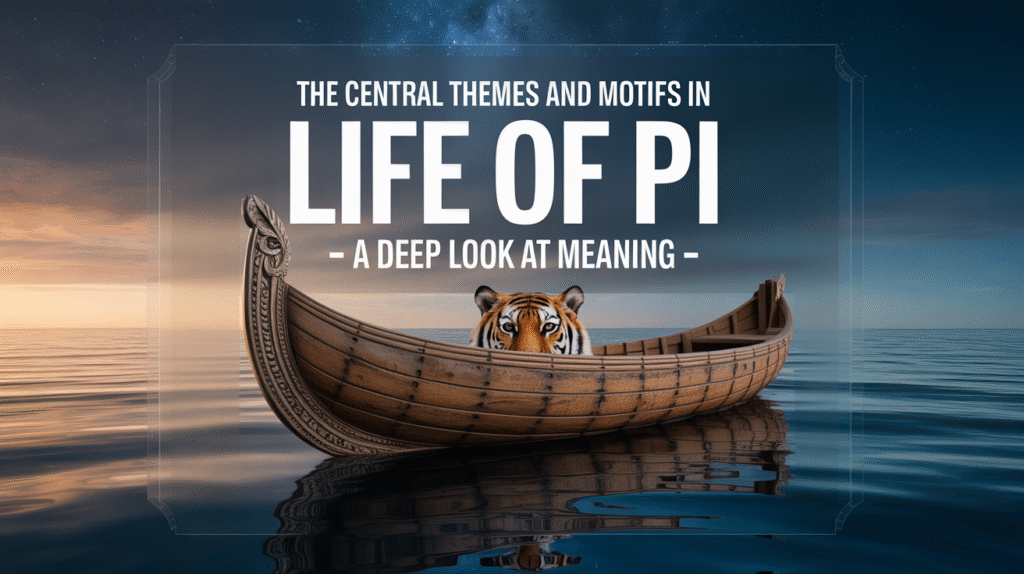The core themes and motifs in Life of Pi center around survival, faith, storytelling, and the nature of truth. These recurring ideas shape the narrative, elevate its emotional impact, and offer readers deep philosophical insights.

Let’s explore these themes and motifs in detail and understand how they give Life of Pi its timeless appeal.
Survival: Beyond Physical Endurance
Survival isn’t just about staying alive in Life of Pi—it’s about mental, emotional, and spiritual perseverance. Pi Patel’s journey tests every aspect of his being.
Physical vs Psychological Survival
- Pi’s struggle with nature is a battle against hunger, dehydration, and fear.
- His inner conflict reveals the toll that isolation and trauma take on the mind.
The Will to Live
- Inventing rituals like feeding Richard Parker and praying helped Pi maintain his sanity.
- Resourcefulness—such as building a raft—symbolizes human adaptability.
Faith: A Pillar of Strength and Identity
Religion isn’t a backdrop in Life of Pi—it’s the foundation of Pi’s worldview. His devotion to Hinduism, Christianity, and Islam shapes his experience.
Faith in God During Hardship
- Praying regularly offered Pi emotional shelter and routine.
- His belief in a higher purpose gave meaning to his suffering.
Religion as Identity
- Pi’s multi-faith practice challenges the idea of religious exclusivity.
- It adds complexity to his character, showcasing how belief systems can coexist.
The Power of Storytelling
The novel is a meta-narrative—it’s a story about stories. Yann Martel uses storytelling not just to entertain, but to interrogate truth and meaning.
Story as Survival Mechanism
- Telling himself stories helped Pi mentally escape trauma.
- Narratives filled the silence of the vast ocean and gave Pi hope.
Stories vs Truth
- The alternative “brutal” version of events questions what we choose to believe.
- Martel asks readers: Do you want a story that’s true or one that’s meaningful?
Nature and the Animal Motif
Animals in Life of Pi are more than characters—they are reflections of Pi’s internal struggles and the human psyche.
Richard Parker: The Animal Within
- Symbolizes Pi’s primal instincts and his darker side.
- Coexistence with the tiger shows Pi’s ability to compartmentalize fear.
The Zoo vs the Ocean
- The zoo represents order and familiarity, while the ocean is chaos.
- The journey mirrors Pi’s descent into survival mode, leaving behind civilization.
Belief vs Skepticism
Life of Pi subtly explores the philosophical debate between believing in something greater and relying solely on logic and reason.
The Writer and the Japanese Officials
- The writer represents the audience’s desire for meaning in fiction.
- The officials challenge Pi, demanding a more “believable” story.
Which Story Do You Prefer?
- Martel directly poses this to the reader, blurring fact and fiction.
- The question becomes a reflection of the reader’s own belief system.
The Sea as a Symbolic Landscape
The ocean is more than a setting—it becomes a living, breathing metaphor for Pi’s spiritual and emotional journey.
Isolation and Immensity
- The sea represents endless uncertainty and the subconscious mind.
- It creates a dreamlike, surreal atmosphere, mirroring Pi’s internal confusion.
A Place of Transformation
- The floating island episode shows how even temporary relief can be sinister.
- The sea constantly tests and renews Pi’s resilience.
FAQ: Life of Pi Themes and Motifs
Here are some questions and answers about the themes and motifs in Life of Pi.
What is the main theme in Life of Pi?
The main theme is survival through faith and storytelling. Pi endures the ocean’s trials by holding onto his spiritual beliefs and crafting a narrative that gives his ordeal meaning.
Why does Pi believe in multiple religions?
Pi believes in Hinduism, Christianity, and Islam because he sees value in each. His multi-faith practice underscores the novel’s theme of tolerance and the search for universal truth.
What does Richard Parker symbolize?
Richard Parker represents Pi’s primal survival instincts and the untamed side of human nature. He also serves as Pi’s emotional anchor throughout the journey.
Why are there two versions of the story?
The dual narratives illustrate the theme of truth versus interpretation. Martel leaves it to the reader to decide which story to believe, challenging how we process reality and fiction.
What role does the ocean play in the story?
The ocean symbolizes the unknown, fear, and spiritual transformation. It’s a place where Pi is stripped of everything familiar, forcing him to find inner strength.
Life of Pi is more than an adventure—it’s a philosophical exploration of the human condition. By unpacking its themes and motifs, we uncover the deep wisdom embedded within Pi’s seemingly fantastical journey.
